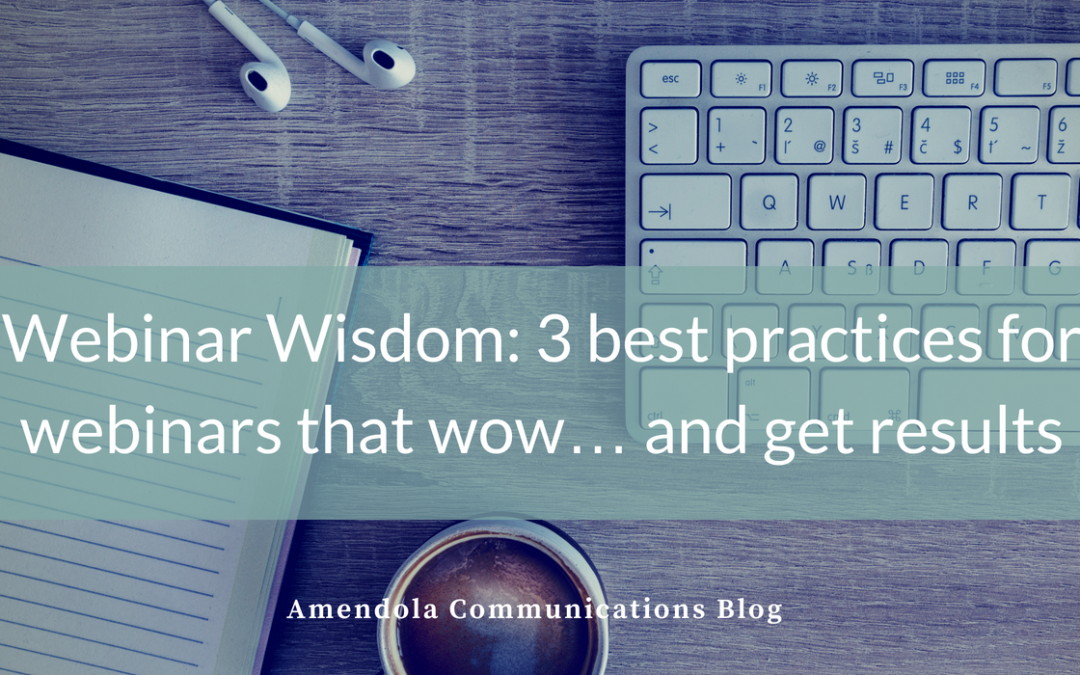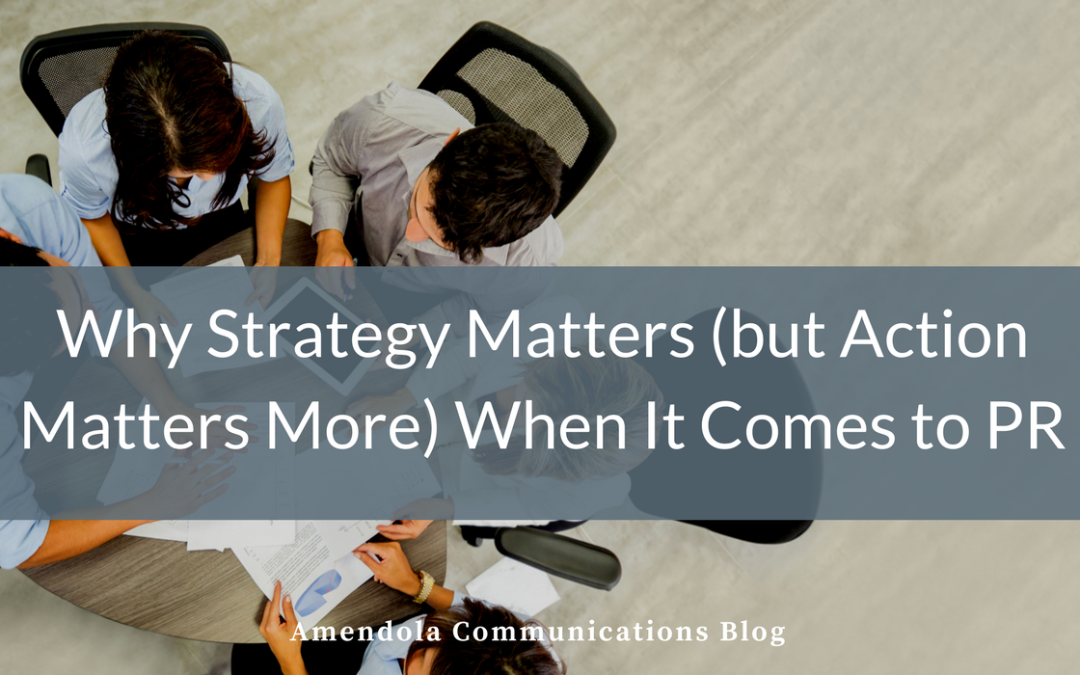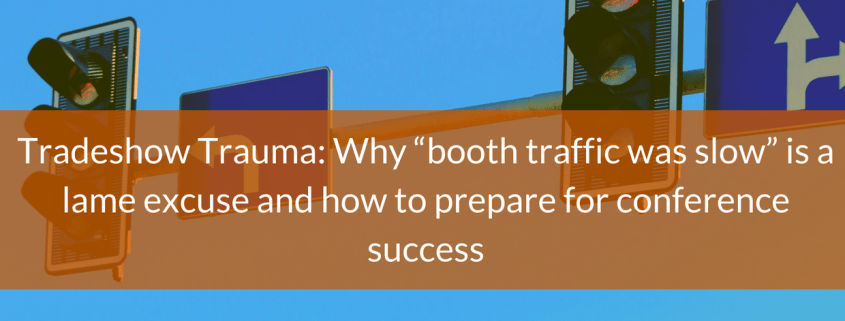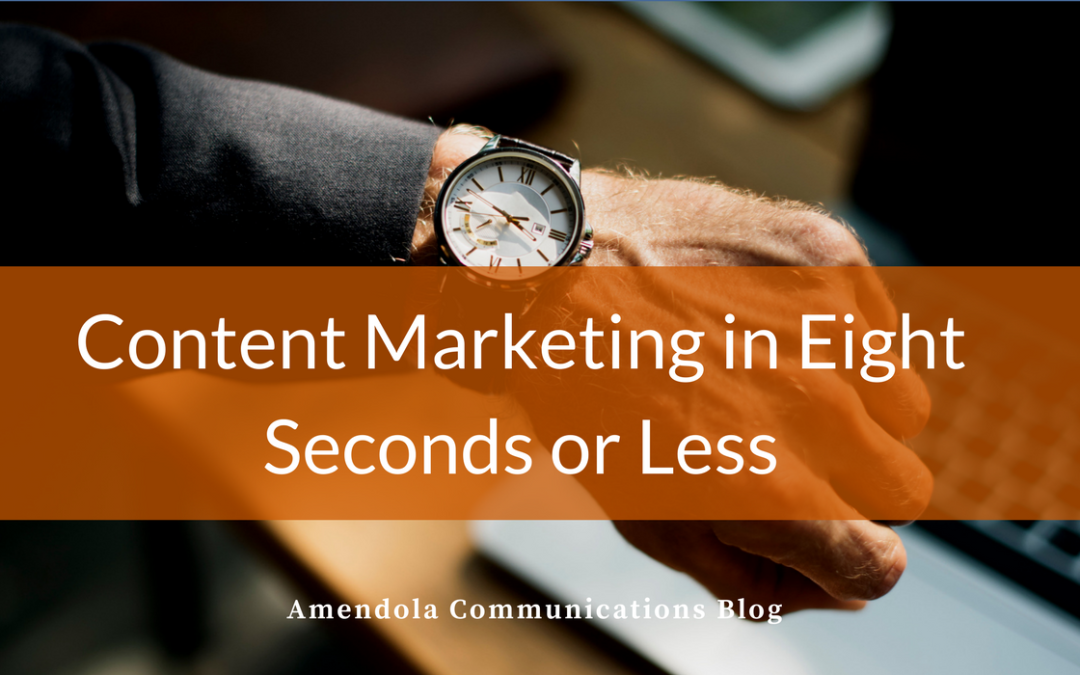
by Lisa Chernikoff | Aug 1, 2018 | Blog
I have a confession. I’m not ashamed. It’s my truth. I love a webinar. I love everything about it. I love writing the title and description. I love promoting it and watching the registration count rise each day. I love when the day finally arrives and the presentation comes to life.
I even love the items on the post-webinar to-do list like sending the follow-up emails to keep the audience engaged, warming up the leads for the sales team or converting them into new sales opportunities. Yes, that’s really why I love webinars. I love the results and by that, I mean the results when everything is done right.
However, I’ve found that many marketing and PR professionals don’t share my pro-webinar passion. In fact, much to my horror and astonishment, many of them are firmly planted in the anti-webinar camp. But I understand their point of view. Most likely, they have been discouraged by a webinar that fell flat, or they simply don’t understand how to harness the true power of a webinar.
As a lover of webinars, with a successful track record over the last decade, I’m here to help with some tried-and-true best practices.
Create customer-focused content
There is almost no better forum than a webinar to highlight your customer’s successes. Why? It’s much different to just read a case study than to have your customers verbally share their stories. On a webinar, attendees can experience that case study live, identify with the challenges and celebrate in the successes which could soon become their own successes with the help of your company.
Now, having a customer co-presenter is the best-case scenario. We know that complete, fully baked customer case studies can be hard to come by or even nearly impossible when companies are launching new products. But there is incredible power in a customer case study that’s still in progress as well. Whether the journey has just begun or the results are preliminary, it’s still better for attendees to hear from their peer rather than just your team.
Webinars with customer co-presenters are almost always more well-attended and more successful. Plus, with customer co-presenters, your company also benefits from being associated with your customer names and brands. Even if someone doesn’t attend your webinar, they may remember that you work with that top hospital.
Prepare for an interactive experience
Even though a webinar is somewhat similar to any other speaking engagement, it’s technically much different. It’s challenging to speak into the phone rather than speak into a crowd of faces that may be either nodding their heads in agreement or nodding off out of boredom. That’s why it’s so important to leverage the technology to create an interactive experience that benefits both your attendees and your speakers.
Even the most basic webinar platforms offer a polling feature which should be used 2-4 times throughout the webinar. We often recommend to clients that they start with a poll question to get a better understanding of what the attendees are looking to learn or why they chose to attend. It can also be helpful for the initial poll question to serve as a gauge for understanding the “level” of attendees. For example, how would they rate their organization’s progress on the journey to value?
Also, did you know that one of the easiest, most painless ways to drive future registrations is right at your fingertips during each webinar? At the end of your presentation, while you still have a captive and hopefully happy audience, simply invite attendees to the next relevant session in your webinar series. When sessions are monthly or quarterly, attendees who enjoyed your webinar usually will vote “yes” via a poll to be automatically registered for the next session.
Focus on follow-up, not just promotion
Lastly, it’s incredibly common for even some of the savviest marketers to focus almost entirely on webinar promotion rather than placing equal importance on the webinar follow-up communications. Don’t neglect the attendees who just spent 30-minutes or an hour with you! They are now primed and ready for more so it’s mission critical to send timely (ideally within 24 hours or less but 48 hours max) follow-up emails to attendees and those who registered but didn’t attend.
It’s also important to send them more than just the webinar recording or the slides. Perhaps you can offer them a new eBook about best practices featured on the webinar or you may have a written case study to share on the same topic. It’s not always about having new content to share. It’s about having relevant content to share and becoming a go-to expert.
Regardless, it’s important for your follow-up communication to be educational and informative to drive continued engagement. After all, once someone spends an hour with you via a webinar, they are more invested. Now it’s about keeping them invested in your content, your customers and most importantly, your company.

by Lisa Chernikoff | Apr 11, 2018 | Blog
We’ve all heard of analysis paralysis the state of over-analyzing or over-thinking a situation so much that a decision is never made and the outcome is impacted. Recently I’ve been witnessing a curious yet similar phenomenon at healthcare IT companies across the country and the analysis paralysis is all about “strategy.” As in overall corporate strategy and direction.
In short, these companies are all about strategic planning, but in the end they seem to come out of it having virtually no strategic plans. They’re all about all-day strategy meetings which result in no strategy but rather more questions that prompt more all-day meetings and shockingly, yet still no strategy.
From the outside looking in, this cycle is an endless hamster wheel that leaves team members feeling tired rather than energized, frustrated rather than empowered, and most troublingly, so terrified that their actions won’t follow the still-to-be-approved (or never-to-be-approved) strategy that they simply don’t act. This inaction can be minor or major as it builds up over time but it’s always detrimental.
Back to basics to get results
Their “strategic focus,” while well-intentioned, sets companies on the wrong path in the short and long-term, especially in regards to PR which should have a constant, ongoing cadence to create momentum and maximize results.
While company strategies can be complicated and have a profound impact on PR efforts, many aspects of PR strategy are quite uncomplicated. In fact, there are core tenets which are quite basic and fundamental to any sound PR plan. There are the pillars that cannot be disputed so they need not be delayed regardless of executive indecision.
Whether your strategy is set or you’re one of many stuck on the endless hamster wheel, these four actions are key to success. They are mission-critical, and safely fit into any PR strategy for 2018 and beyond:
1. Write and distribute press releases
It sounds like a no-brainer but for many companies it’s not because they live in fear of being “off brand” or “misaligned.” They live in fear of putting out too many press releases yet not enough press releases. Those fears are unwarranted though since your company is doing good work. Why shouldn’t it be shared? Did you develop a new product? Let’s write a release. Did you sign a new customer? Let’s write a release. Is your CEO speaking at an industry event? Let’s write a release.
Writing a press release is one of the simplest ways to communicate what’s happening and why it matters. Distributing those press releases positions your company as a key player and thought leader in the ongoing industry dialogue. It’s not complicated. It doesn’t need to be debated and as long as you’re not regularly putting out more than 2-4 press releases per month, you’re not overdoing it. So, just do it.
2. Highlight your customer’s success stories
Once again, it sounds like a no-brainer. You have customers. They like your products. They like your team. They have achieved impressive results that they’re willing to share. Let them be your advocates. Capture their stories in writing. Put them in front of reporters who are eager to hear from both executives and end-users at provider organizations. It’s as simple as that. Just like with press releases, these customer success stories illustrate that your company is doing good work and that’s what makes more customers want to work with you, which of course is one of the biggest end goals of any strategy. It’s not complicated. It doesn’t need to be debated. As long as your customers are singing your praises, hand over the microphone and let them sing.
3. Emphasize your expertise
In addition to highlighting your clients, highlight your company’s thought leaders. After all, they are also doing good work (you may see a pattern here). They have knowledge to share. They have ideas to contribute. They are the faces of your company and you need some faces even if you don’t have a final strategy. This action can mean authoring bylined articles or blogs on their behalf or pitching them as experts for media interviews. By positioning your executives and SMEs as thought leaders and joining the industry conversation, you’re helping to make your company a go-to source for future media opportunities. It’s not complicated. It doesn’t need to be debated and it would really be a shame for their knowledge to go to waste.
4. Educate your sales team about PR efforts
Regardless of strategy indecision, your sales team needs to close deals. There is nothing off-strategy about building your business. Media placements from your PR efforts are one of the most powerful but underutilized tools in your sales team toolkits. Obviously, sales prospects are not interested in the same information as the media. In fact, they may be turned off by being sent a press release about a new client that just signed on. However, they may be very interested in press coverage from well-regarded industry publications that profile your company news, thought leadership, and customer success stories. That is not only informative but also adds credibility and implies that you want to keep them in the know.
Similarly, if one of your client case studies is featured in a third-party publication, that’s a prime opportunity to reach out, share the article and offer a reference call with the client quoted. It’s not complicated. It doesn’t need to be debated and if you’re earning media placements it is certainly a shame not to use them to their fullest potential.
It’s time to get off the hamster wheel and get on with the real work that makes a difference.

by Lisa Chernikoff | Jan 3, 2018 | Blog
As a marketing and PR professional who has spent countless hours in tradeshow booths and walked more than 20,000 steps at the HIMSS conference while wearing heels, I’ve experienced both the glory and the defeat of being an exhibitor. And while there is no better feeling than packing up your boxes, tearing down the booth and heading home after a job well done, there is also no greater pain than realizing that your company’s precious time and resources were virtually wasted because your conference strategy fell short.
After every tradeshow, it’s common to speak with exhibitors who complain that “booth traffic was slow” and cite that reason as the root of their conference failure. But let’s be honest — that’s a lame excuse. It’s the easy way out to blame poor performance at the show on exhibit hall organizers rather than reflecting on how your team may be at fault, or at least largely contributed to the problem.
In fact, upon much-needed reflection, those complainers would see that they are likely committing the cardinal sin of tradeshow marketing. They’re only focused on the conference. They’re not focused on the holistic strategy that enables the smartest, more successful companies to succeed at conferences again and again and again.
To avoid this tradeshow trauma and emerge triumphant in 2018, it’s critical for companies to have a three-pronged approach that includes not just a conference strategy where you show up and wait, but also and even more importantly a pre-conference strategy and a post-conference strategy.
Here are 4 insider secrets to help you get started:
#1 Never rely on booth traffic
Sure, booth traffic is nice and we all want it but it’s even better to drive traffic to your booth in advance. As savvy marketing professionals know, the best tradeshow marketing strategies start early and establish a regular cadence of communication. Most companies find that implementing a targeted email campaign starting 6 weeks in advance of the show is ideal but some may find that 8 weeks or 4 weeks works best for their audience.
These emails should be geared to both sales prospects to schedule meetings or demos and current clients to have a face-to-face touchpoint and determine cross-sale opportunities. As always, the top-performing emails are brief and targeted to attendees by role and job setting. It’s also best to have a form where attendees can schedule time and then receive a confirmation with a calendar invite. Why is that so important? It gets you on attendees calendars before they arrive at the show and are overwhelmed. Also, then your team can send them reminders about the scheduled slot or reach out if they don’t arrive as planned.
#2 Winning is great but winning isn’t everything
Pre-conference email campaigns can also invite attendees to activities in the booth such as speaking events or games instead of just meetings and demos. They can also offer attendees “a chance to win” and highlight big prizes, but they must not rely on the allure of a gimmick alone. There are few too many promotions for your giveaway to break through the noise. A pre-conference strategy that shares quality content, in addition to touting “a trip for 100 around the world” is the safest, most effective way to not only illustrate thought leadership but also to create brand awareness of your company as leader and innovator that offers far more than just a chance to win ““ but rather real ROI.
#3 Think like an attendee
Spoiler alert for those many hours spent in the booth. Nobody wants your marketing brochure! It will end up in the next trash can even if they take it, and if it makes it back to their room, it will end up in the hotel trash can. They also really don’t want a folder with multiple product one-pagers and a recent press release about your new product. Please note that this realization also spares your marketing team and admin hours of folder stuffing. Yes, you’re welcome.
The big idea here is to remember why attendees are at the conference. Most attendees are there to learn, not to purchase your “ground-breaking, best in class, fully integrated solution.” So, give them what they want like client case studies with real-world insights and thought leadership that demonstrates your knowledge and unique perspective. That’s the true value proposition that won’t get throw in the trash.
#4 Follow-up, follow-up, follow-up
It’s great to have a successful show, but it’s what companies do afterwards that matters most. It’s all about the follow-up communications, which should include a series of e-blasts, with the first prepared ahead of time and sent within 1-2 days of show close. The post-show e-blast should provide an opportunity to continue to engage with your company by downloading a new piece of content, registering for a webinar, or scheduling a full product demo for their broader team. However, the e-blast is not enough. To see results, it must be complimented by personalized follow-up from the sales team where there is even a small percentage chance of generating new pipeline. Without this timely and dedicated post-show communications, it’s impossible to reap the benefits of your hard work pre-show and at the show.
Remember, it doesn’t matter how many people attend the tradeshow. Only that the right people make it to your booth.
Instead of leaving success to chance, put together a three-prong plan that will tip the odds in your favor. It sure beats coming up with lame excuses later.

by Lisa Chernikoff | Oct 4, 2017 | Blog
As you work on your content strategy, think about this: According to a recent study, the average person now loses concentration after only eight seconds. I would ask you to pause and think about that but then I’ll risk of losing the remaining seconds of your attention entirely if I haven’t already. As a “fun fact,” researchers noted that even goldfish which are “notoriously ill-focused” have an average attention span of nine seconds.
So, whether that fact is fun or concerning is still be determined, but it really isn’t that shocking. This study simply quantifies the impact of a highly digitized lifestyle on the human brain. After all, we live in a world where our phones are constantly buzzing with emails, texts, news alerts, and social media notifications. We live in a world where”
Sorry, I got distracted for a moment. Did you know that Kim and Kanye are expecting their third child via surrogate? My phone just vibrated with that “breaking” news, as well as four work emails, three personal emails, and two trivial text messages. And even if celebrity gossip isn’t your guilty pleasure, you’re likely experiencing a similar scenario every hour of every day.
But to be clear, the aha moment from this study is not that goldfish are smarter than us. It’s an aha moment for us as marketing and public relations professionals. The study has profound implications for those of us who communicate for a living. To be successful, we must adapt our strategies and tactics to the reality of eight second attention spans.
Why evolving content doesn’t mean dumbing it down
In today’s world of digital and information overload, crafting content that is relevant and meaningful for your target audience is mission-critical. Remember that having shorter attention spans doesn’t mean that your customers are not decision-makers. It doesn’t mean that they’re less intelligent. It doesn’t mean that they don’t have the same pain points. It just means that they need to absorb information differently. It just means that despite downloading your white paper, they’re probably not getting past page one. There’s no shame. It’s the new normal.
That’s why evolving your content marketing is not about dumbing down the information. It’s not about simplifying or going back to basics. It’s about making your content snackable. In fact, your new bite-sized content can still convey the same concepts and ideas as the longer pieces but that content must be more concise and free of fluff.
Even more importantly, it must provide just a taste to satisfy their brief hunger and keep their interest. It must leave the audience wanting more of your content snacks. That’s what marketing is all about.
How to create tasty content snacks a recipe for success
Snackable content for the eight second attention span is just a new way of creating, organizing, and promoting content. To create tasty content snacks, you don’t need to start from scratch. You don’t need all new ingredients. Your content kitchen is likely full of big, heavy content meals which can be remixed and reused to fit the new snackable content mold. The good news is that one content meal equals several content snacks.
Now, let’s enter the content kitchen and see how to turn those content meals into content snacks. Here are three examples:
- Transform your white paper into an infographic and a cheat sheet with must-do’s.
- Transform your case study into a checklist of best practices, or a series of checklists that span everything from implementation to training and optimization.
- Transform your 30-minute webinar into a sequence of 30 second videos that highlight that key learning objectives.
And rather than being sad about the lost of art of white paper reading, keep in mind that multiple content snacks derived from the same content meal not only convey the same messages but also can easily become a lead nurturing campaign or useful follow-up references for your sales team to share with prospects.
I think it’s time to stop mourning the white paper. Instead, it’s time to cook up some bite-sized content. After all, it’s just waiting to be eaten.

by Lisa Chernikoff | Jun 21, 2017 | Blog
Here’s a valuable lesson for anyone involved in content marketing.Recently, I was chatting with a small group of guests at a party. Then, the other partygoers gracefully exited the conversation and suddenly, I was trapped. I looked right. I looked left. But my efforts were futile. I was officially stuck in a never-ending conversation. Yes, I had entered the dreaded Party Vortex, which is similar to the Polar Vortex but much less cold and much more dangerous.
But the real problem, and what made the circumstances so precarious, is that the never-ending conversation wasn’t a conversation at all. It was a monologue without audience participation. It was a soliloquy but far less articulate. It was all about my new acquaintance, who would most certainly not make the cut to be called a friend. As he continued to talk at me for 20 minutes, which felt like 20 hours, I smiled and nodded but secretly plotted my escape. Yet, despite my best Party Ninja skills, there was no way.
Spoiler alert: I survived this party trauma and lived to tell the tale. But sadly, this blog is not about party etiquette. It’s about content marketing because my Party Vortex nightmare is undeniably similar to the experience that potential customers might be having with your content right now.
While content marketing missteps are many and frequent, the biggest, most overarching mistake is that your content is all about you. It’s all about your company and your solutions. It’s all about your technology saving the world. This is the sort of content that not so subtly shouts “buy this.” After all, isn’t that your end goal?
However, touting the features and functionality of your newest product under the guise of a white paper often fails to make an impact especially as healthcare professionals becomes savvier to the idea that they’re being sold to everyday. It falls short because it doesn’t take readers, your potential customers, into account. It doesn’t address what readers really want to know and what will compel them to take action. It leaves readers hanging, and then what happens?
Rather than completing a “contact us form” on your website to learn more, they’re lost to you. They may have simply decided that it’s not the right time to buy or that your company isn’t the right partner. They may have even gasp moved on to one of your competitors.
From company-focused to customer-focused
When developing a content marketing strategy and crafting each piece of content to support that plan, it’s critical to keep your future customers top-of-mind. Remember that every decision-maker or influencer that engages with your content could be your newest client, smartest super user, or most reliable reference.
How can you better connect with your audience? It’s simple but shockingly hard to do. Write what they want to hear about, rather than writing what you want to say. Write what they are hungry to learn about, rather than what you’re desperate to teach them. It’s a small change in perspective that makes a big difference. And while that may seem obvious, it’s not abundantly clear to many marketing and PR professionals unless they’re just doing it wrong.
Effective, customer-focused content prompts an “aha moment,” by sharing new ideas or even the same old ideas in a new way. This matters because encouraging readers to think differently is the first step to being seen as a thought leader in their minds and then as the ideal strategic partner.
These new perspectives aren’t necessarily earth-shattering but they draw readers in. Customer-focused content addresses the problem you’re solving, not just the solution.
It also doesn’t oversimplify the solution by presenting painless and perfect success stories of IT solutions that were seamlessly implemented and quickly gained adoption by all end users. Further, it provides insights on process improvements, change management, and other tactics that readers can put into action, aside from just buying your technology.
Real-world tips and lessons learned are valuable takeaways that readers appreciate much more than a bulleted list of your product’s bells and whistles.
Your new customer-focused content will not only satisfy readers but also help turn more potential customers into actual ones. Even more importantly, we know that your new, improved content will ensure that you’re invited back to the party. And isn’t being invited back to the party the ultimate goal of any marketing?




